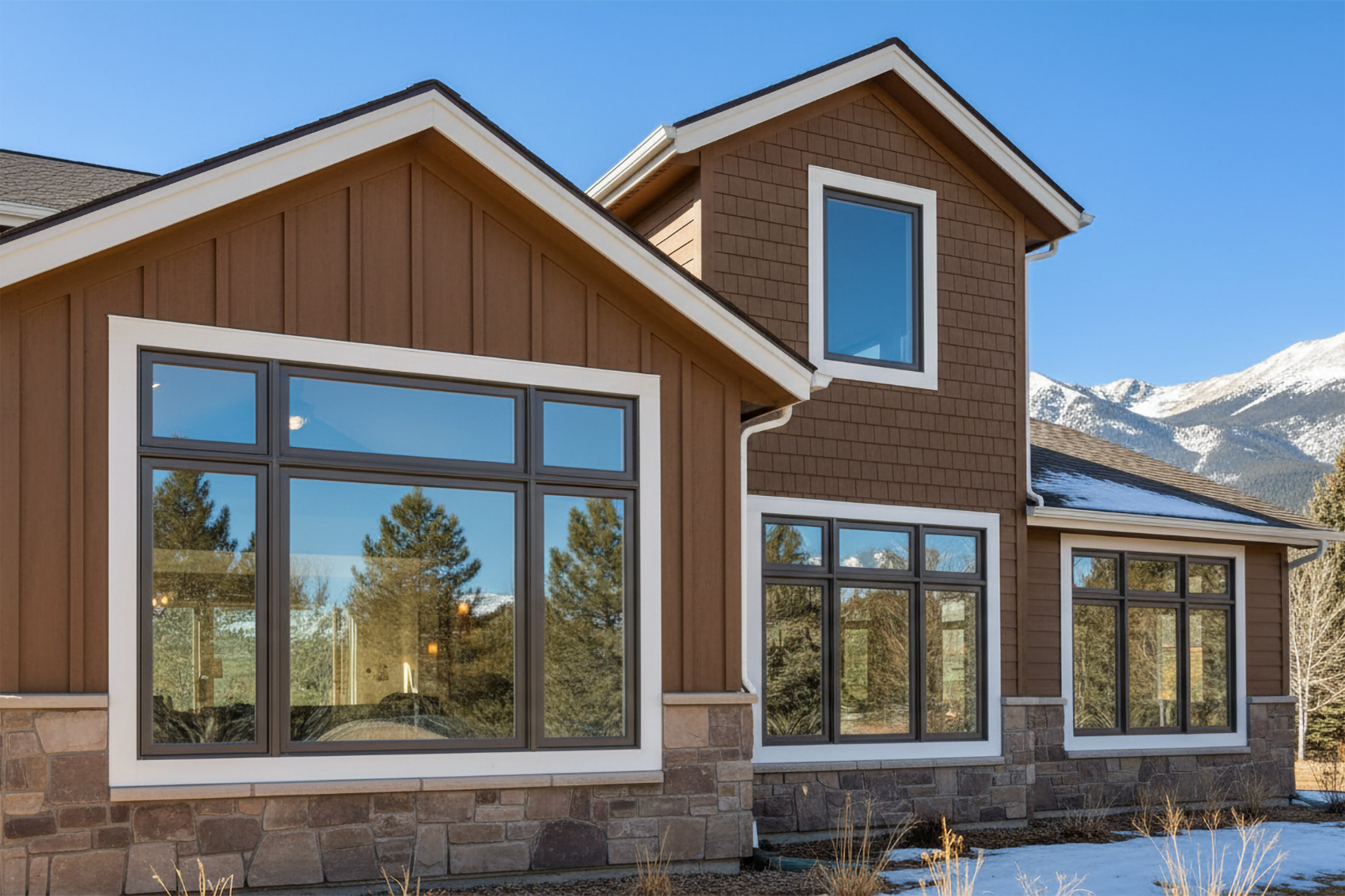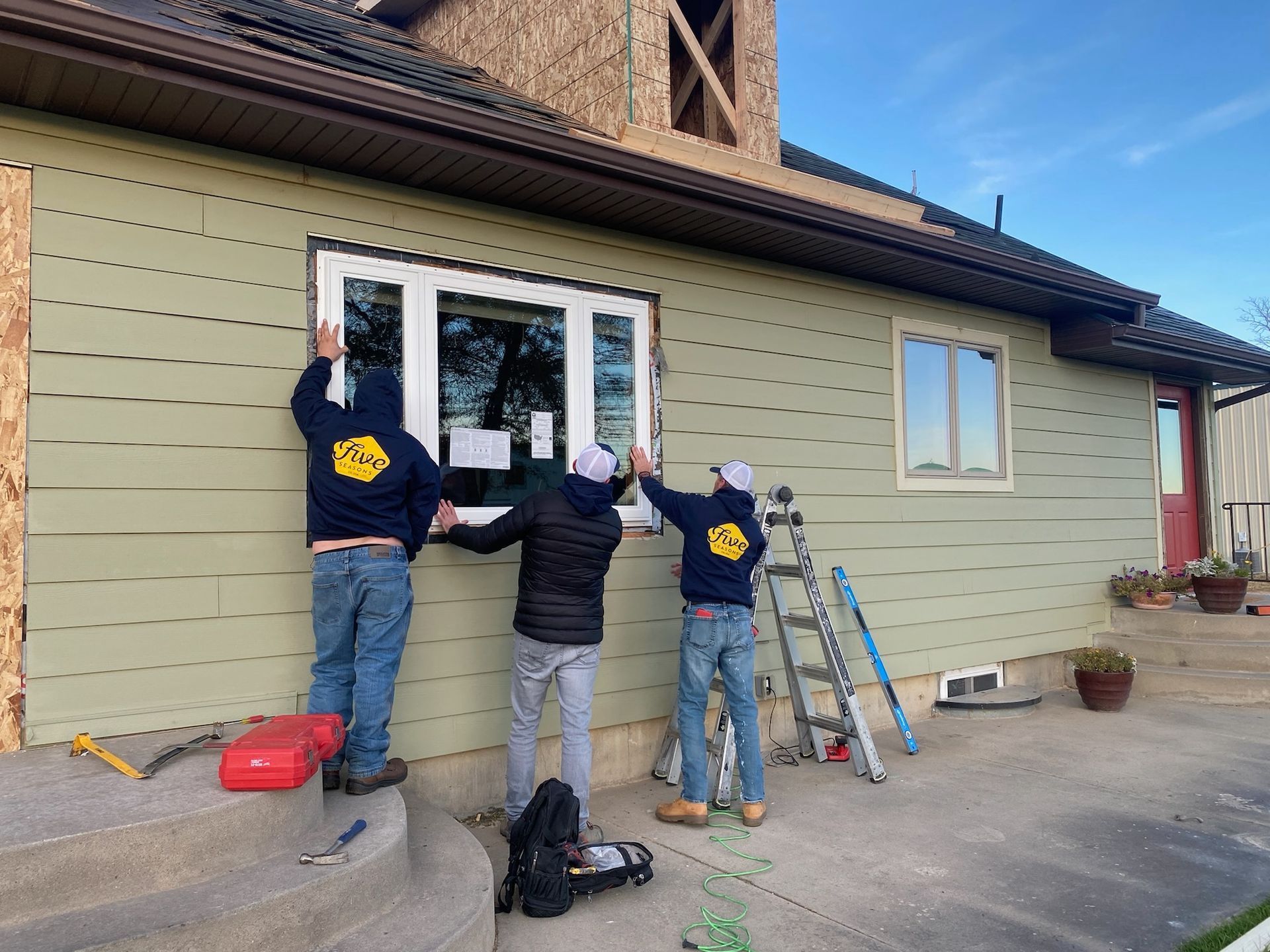Upgrading from single-pane windows to modern dual-pane glazing is an effective way to improve home comfort and reduce drafts in Colorado’s demanding climate. Dual-pane systems provide an insulating barrier between two layers of glass that helps moderate indoor temperatures when paired with the appropriate Low-E coatings and gas fills.
For Colorado homeowners considering window replacement—whether choosing high-performance vinyl products like Anlin or premium wood/aluminum designs such as Marvin Signature® Ultimate—understanding NFRC-rated performance, orientation-specific glazing needs, and high-altitude installation requirements ensures a more informed long-term investment. At Five Seasons Windows & Doors, we review NFRC labels for the exact units being ordered and assess home-specific factors such as elevation, solar exposure, shading, and existing insulation before recommending a solution.

How Dual-Pane Glazing Improves Thermal Performance
Dual-pane windows slow heat transfer by using two panes of glass separated by a sealed air- or gas-filled cavity. This reduces heat flow through conduction, convection, and radiation, especially when the glazing uses the right Low-E coatings for Colorado’s mix of cold winters and strong, high-altitude sun.
Low-E coatings reflect indoor heat back into the home during winter and help reduce solar heat gain during summer. Performance varies based on:
● Low-E type and placement
● Gas fill strategy (argon is common at lower elevations)
● Frame material
● Size and operator type
● Orientation
● High-altitude pressure considerations
At elevations above 6,000 feet, sealed insulating glass units may require pressure-equalized or capillary-tube configurations to maintain proper performance. NFRC ratings represent whole-unit performance, not center-of-glass values, and homeowners should always review the NFRC label for the specific window configuration they are purchasing.
Low-E Coating Selection for Colorado
Colorado’s solar intensity varies significantly by orientation:
● South- and west-facing windows often require stronger solar-heat-gain control due to intense afternoon sun, especially at altitude.
● North- and east-facing windows may benefit from coatings that allow more passive heat gain during winter.
Selecting the correct Low-E strategy ensures balanced year-round performance. Five Seasons Windows & Doors evaluates each façade of your home to match glazing accordingly.
Typical Installation Costs and Project Considerations
The cost of replacing windows depends on several factors:
● Window size and operating style
● Frame and cladding materials
● Interior and exterior finish choices
● Installation scope (trim work, structural modifications, access)
● Orientation-specific glazing selections
Vinyl products such as Anlin provide strong energy efficiency, low maintenance, and UV stability at moderate investment levels.
Marvin Signature® Ultimate windows provide a premium option with wood interiors and extruded-aluminum exteriors featuring AAMA 2605-certified finishes engineered for high-UV durability.
Exact project pricing varies based on design, window count, and installation requirements. Five Seasons Windows & Doors provides detailed project evaluations and estimates tailored to your home.
(This article does not provide price guarantees or specific cost predictions, as actual project costs vary.)
Energy Efficiency and Real-World Comfort Benefits
Many homeowners notice improvements in comfort, reduced drafts, and more stable indoor temperatures after upgrading from single-pane to dual-pane windows. However, energy savings depend on:
● Building insulation
● Air-sealing levels
● HVAC system performance
● Glazing configuration
● Orientation and shading
● Installation quality
Dual-pane windows paired with the right Low-E coating help moderate temperature swings, especially on large glass areas facing afternoon sun or winter winds.
Energy savings will vary by household and cannot be guaranteed.
Condensation Resistance and Moisture Control
Single-pane windows often allow condensation to form during cold weather because the interior glass surface becomes very cold. Dual-pane glazing typically maintains a warmer interior surface, reducing the chance of condensation under typical indoor humidity levels.
However, any window can experience condensation if indoor humidity is too high, especially during winter. Ventilation, air circulation, and humidity management remain essential.
Dual-pane glazing helps reduce conditions that contribute to moisture-related concerns and helps protect finishes, sills, and surrounding materials from recurring moisture exposure.
If you are considering additional acoustic or thermal performance improvements, see our deeper guide:
🔗Why Choose Triple-Pane Window Installation for Improved Comfort and Energy Efficiency
Frame Material Considerations for Colorado’s Climate
Vinyl (Anlin)
High-quality vinyl products offer durable, low-maintenance performance with multi-chambered frames that help improve insulation. Anlin’s UV-stable formulations are designed to resist brittleness and fading in high-altitude sun.
Marvin Signature® Ultimate (Wood Interior / Extruded Aluminum Exterior)
These windows combine a wood interior that allows refinishing and architectural flexibility with an extruded-aluminum exterior protected by an AAMA 2605-certified finish engineered for long-term color stability. Their material combination is designed to withstand Colorado’s temperature swings, wind exposure, and UV intensity.
Each product category serves different homeowner priorities, and the right choice depends on architectural style, desired aesthetics, budget, and long-term performance expectations.
High-Altitude Considerations
Colorado’s elevation affects window performance.
At higher elevations, insulating glass units may require:
● Capillary tubes
● Pressure-equalized glazing
● Specific Low-E combinations
● Altitude-ready gas strategies
Five Seasons Windows & Doors evaluates each project’s elevation to ensure the correct glazing configuration is selected.
Why Installation Quality Matters
Even the highest-performing NFRC-rated window must be installed correctly to achieve its intended performance. Whole-unit ratings apply only when:
● The window is installed square and level
● Weather sealing is properly integrated
● Frame expansion and contraction are accounted for
● High-altitude pressure considerations are followed
Proper installation is essential in Colorado’s climate, where wind, snowpack, and temperature swings can quickly expose weaknesses in poor installations.

Our Take
At Five Seasons Windows & Doors, we help Colorado homeowners replace aging single-pane windows with well-specified dual-pane systems designed for our region’s climate. By matching each home’s elevation, orientation, and design goals with appropriate glazing, frame materials, and installation practices, we provide balanced recommendations without overstating performance.
Final Takeaway
Upgrading from single-pane to dual-pane windows can provide noticeable improvements in comfort, temperature stability, and moisture resistance when paired with the right glazing and installed correctly. For the most accurate expectations, homeowners should review NFRC labels for specific window configurations and work with experienced installers familiar with Colorado’s elevation, UV intensity, and temperature swings.
Actual performance will vary based on window size, configuration, glazing selection, home insulation, HVAC operation, and installation quality. This article does not provide medical advice or guarantee energy savings.
When properly specified and installed, dual-pane systems are engineered for long-term durability and performance across Colorado’s unique climate conditions.
Get Started Today
Five Seasons Windows & Doors is Colorado’s top-rated local window company with 230+ 5-star reviews. We offer expert advice, no-pressure quotes, and flexible project options — including phased installs. Schedule your consult today.



